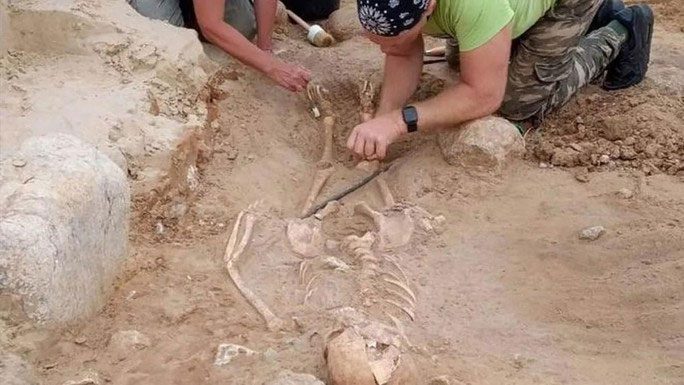The 400-year-old skeleton that was “sealed” through procedures for a “vampire” has aided scientists in identifying the mysterious cemetery in Pień, Poland, as a place designated for “abandoned souls” in local legend.
According to Ancient Origins, the ancient Polish legend of vampires has long mentioned graveyards that locals feared, where they buried those accused of being vampires through chilling rituals.
In the historic village of Pień in northern Poland, an area resembling an unrecorded graveyard has been discovered over the years, revealing strange artifacts among the impoverished graves.

The vampire child skeleton at the Pień village cemetery – (Photo: Wojciech Miłek/NCU).
Recently, Polish archaeologists uncovered an intact grave that helps clarify this eerie mystery.
According to Live Science, it is the skeleton of a child aged 5-7, buried face down with a large lock at the feet.
“The lock suggests that people were afraid of this child after its death,” said archaeologist Dariusz Polinski from Nicolaus Copernicus University in Torun, Poland.
This is the third lock found in this graveyard. Previous locks were not found in their proper locations or on intact skeletons, leaving archaeologists puzzled about their purpose.

Strange-shaped lock as a “vampire seal” – (Photo: Wojciech Miłek/NCU).
The new discovery about the child, who is believed to have died around 400 years ago, in a face-down position confirms that this is a “vampire” grave.
The face-down position has been observed in several other “vampire” graves. In the case of adult graves at other sites, more brutal rituals—including wooden stakes driven into the body and skulls placed at the feet—have made it easier for scientists to confirm their findings.
The cemetery in Pień, which contains around 100 graves, does not lie within the sacred grounds of churches like other medieval cemeteries, further affirming its significance.
Some other graves also contain bizarre items that scientists have yet to explain clearly, while some graves are clearly for the poor, who may not have been able to afford proper burial rites.
However, the cemetery also includes wealthier individuals, such as the skeleton of a woman discovered last year who wore a gold sickle around her neck, was dressed in gold, and had consumed a type of medicine containing gold before her death. She was also identified as a “vampire.”
This discovery provides a valuable piece to the puzzle of the “vampire” legend in ancient Europe, where terrifying superstitions were imposed on those accused of being vampires.
Modern science reveals that most medieval “vampires” suffered from various infectious and genetic diseases, causing pale skin and light sensitivity, leading them to drink animal blood instead of receiving blood transfusions as we do today. The lack of knowledge during the medieval period led to discrimination against them, even after death.

















































